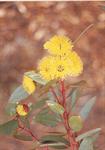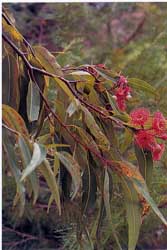 Learn to Grow and Use Eucalyptus
Learn to Grow and Use Eucalyptus
"Propagate and care for eucalyptus"
This is a course for amateurs and professionals; land managers, farmers, plant collectors and breeders, nurserymen, botanists, landscapers, gardeners and horticulturists.
COURSE STRUCTURE
The content of each of the eight lessons is as outlined below:
1. Introduction. Review of the system of plant identification, general characteristics of the group, information contacts (ie: nurseries, seed, clubs etc.)
2. Culture. Planting, staking, mulching, watering, pest & disease, feeding, pruning, protection from wind, salt air, etc.
 3. Propagation. Methods of propagating this group of plants.
3. Propagation. Methods of propagating this group of plants.
4. The most commonly grown varieties.
5. Other important groups.
6. Lesser grown varieties.
7. Making the best use of Eucalypts
8. Special Assignment. On one selected plant or group.
Duration: 100 hours
Aims
- Describe the classification of Eucalypts.
- Discuss general cultural requirements for growing Eucalypts.
- Propagate Eucalypts.
- Differentiate between identifiable characteristics and cultural requirements in a number of commonly cultivated Eucalypts.
- Discuss characteristics of a wider range of Eucalypt species.
- Describe commercial uses for a range of different Eucalyptus species.
- Plan the establishment of a collection of different cultivars of Eucalypts (eg. Gums, Mallees, Tall Trees, Short Trees, Dryland Species), suited to growing in a specified locality.
 What are Eucalypts?
What are Eucalypts?
Eucalypts can vary from low shrubby plants to huge trees, which are in fact the tallest flowering plants in the world. They can occur in all types of environments, from deserts to wet rainforests, from sea level to high altitudes, and from the tropics to cool temperate places that are blanketed by snow for many months of the year.
Lignotubers
Most eucalypts produce lignotubers. Tuberous swellings develop in the axils of the cotyledons and the first few leaves. These unite to form a tuberous mass which may continue to grow and become woody. It contains several dormant vegetative buds which develop upon death of the plant stem (brought about by fire, drought or physical action) and produce new stems.
Epicormic Buds
Epicormic buds are dormant vegetative buds which lie beneath the bark. They allow the tree to regenerate following destruction of the crown, for example by fire.
Bark Variations
The bark of eucalypts varies with the plant’s age, the manner of shedding bark, the degree of furrowing, the colour, hardness and thickness. Mature eucalypts gain a layer of bark each year which contributes to the expansion of the tree’s girth. The outermost layer of bark dies each year. In some species the dead bark is shed completely, either in one season or in phases throughout the year. These are known as smooth barked species. The bark may be shed in long strips or in different sized flakes.
In other species the dead bark is retained. These are known as rough barked species.
‘Half-barks’ or ‘blackbutts’ are species in which the dead bark is shed on the upper half of the trunks and retained on the lower half.
The newly exposed smooth bark of some smooth-barked species and half-barks may bear different colours, e.g. orange or yellow, fading to grey.
If the smooth bark is covered with a layer of white powder, a powdery bark-type results.
Taxonomy
The botanical classification of Eucalypts has changed a lot in recent decades, and some changes have been controversial, and not accepted readily by all experts. This situation can sometimes make the naming appear confusing.
This course will help you to grow your knowledge of Eucalypts and understanding of why some information may appear contradictory.
Study, learn to identify, and grow Eucalypts, across a wide range of situations.
WHAT NEXT?
Register to Study - Go to “It’s Easy to Enrol” box at the top of the page and you can enrol now.
or
Get Advice – Email us at info@acsedu.co.uk OR
Use our FREE COUNSELLING SERVICE to contact a tutor
CLICK TO CONTACT US